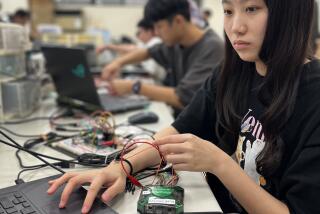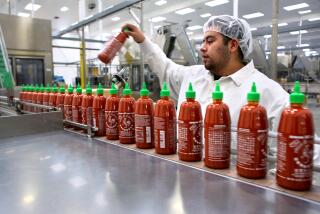Parts Shortages Take Huge Toll on Tech Sales
- Share via
Soaring demand for everything from the computer servers that run office networks to the latest Pokemon toys has lead to an unprecedented shortage in electronic components that is expected to last through the holiday season and well into next year.
Because of the parts shortages, some retailers are out of the newest Palm hand-held computers, while many laptop computers on store shelves aren’t equipped with disk drives that allow music from the Internet to be recorded on private CDs.
For example, one Circuit City in San Jose said it was running short of Palms, Compaq iPaq Net appliances and Hewlett-Packard and Casio hand-held computers.
While consumers have to settle for slower home PCs, corporate giants, including top electronics maker Matsushita and computer giant IBM, are watching hundreds of millions of dollars in potential sales evaporate. Across the computer industry, the sales shortfall could reach into the billions of dollars this year.
In some cases, huge pieces of equipment aren’t shipping for lack of semiconductor microprocessors worth a few hundred dollars or tiny electrical circuit capacitors that sell, when you can find them, for a few pennies.
Parts suppliers blame the decade-long U.S. economic boom that has spurred demand for waves of new products faster than billion-dollar factories for semiconductor chips and other key components can be built, which takes a year or more.
Executives such as Dick Rosen, whose Myrtle Beach, S.C.-based AVX Corp. makes capacitors, are suddenly being pursued like Hollywood stars. “I’ve gotten calls in the middle of the night from Tokyo from someone needing a crummy old 5-cent capacitor for a half-million-dollar piece of communications equipment,” Rosen said. “We do the best that we can.”
AVX is running its 26 plants three shifts a day, seven days a week. Sales have almost doubled in a year, profit is up sevenfold. Similar stories abound at other obscure component makers.
Scarcity has led to some over-ordering, even hoarding, of parts.
“The industry was ordering six to eight weeks in advance. Now it’s four and six months, and that’s exacerbated it,” said analyst Mark FitzGerald, a semiconductor chip analyst at Banc of America Securities.
While previous shortages involved only a handful of parts, lasted a few months and affected a few types of machines, the new must-have parts run the gamut from Intel’s high-end Xeon chips for computer servers to cheap liquid crystal display screens.
“There are a lot of funny little parts you never knew you needed,” said computer industry analyst Roger Kay of International Data Co. “It’s like your bile duct valve on your liver. You don’t know you have one, but if you get cancer there, you’re cooked.”
Parts Makers See Demand Plunge, Soar
For many companies that make the parts in the brutally cyclical electronics industry, it’s a dramatic reversal of fortune.
In the mid-1990s semiconductor chip makers, including Intel and its rivals across Asia, invested billions of dollars in state-of-the-art fabricating plants that turned out speedier and speedier computer chips. Sales were soaring, but the only way to stay competitive was to spend massively to make parts that did even more at lower cost.
Then, starting in 1996, the Japanese stock market tumbled by nearly half in two years. With demand for consumer products in Asia shriveling, the big chip makers stopped spending on new plants.
When the Asian economy came back, along with the roaring U.S. economy, so did demand for not just one or two types of products, but seemingly everything at once. More than 28 million cell phones were sold in the U.S. in 1998, and that figure will reach 73 million this year, IDC says. And Palm and other hand-held electronic organizer sales doubled from 1.8 million to 3.6 million in the same period.
“They really got caught flat-footed,” said analyst FitzGerald.
And since the parts makers were hurt by the Asia slowdown, they were reluctant to start pouring in money again to boost capacity.
“It was ‘once burned, twice learned,’ ” said Ian Ross, vice president of manufacturing at Agilent Technologies, the Hewlett-Packard spinoff that makes sophisticated testing and measurement devices.
Contributing to the shortage were some poor sales forecasts by chip leader Intel that led it to cut spending on new plants and equipment from 1997 through 1999.
One of Intel’s biggest customers is Compaq Computer, whose Chief Executive Michael Capellas complained this month that the parts shortage was the worst in memory. Matsushita said a lack of parts cost it $270 million in revenue last quarter.
Other companies blaming the parts problems for lost sales or profits include PC maker Dell, consumer electronics firm Sony, toy makers Nintendo and Hasbro and cell-phone maker Ericsson.
At the heart of this shortage are prized commodity parts used in multiple industries.
In part because of the popularity of music-swapping services such as Napster, laptop computer buyers demand the ability to create their own CDs from downloaded music. But the disk drives needed to download music from the Internet onto a personal CD depend on tiny components that also are sought by the booming cell-phone industry. Gateway, Dell, Compaq and others are either leaving the drives out of some laptop computer models or are suffering with order backlogs.
As a result, worldwide revenue from computer sales--projected now at $217 billion this year--might be 4% to 8% lower because of these shortages, Kay said.
The situation isn’t likely to change for at least six months or a year, analysts said. “Demand has been very healthy, and it doesn’t look like it’s slowing,” said analyst John Jones of Salomon Smith Barney.
Part of the problem is the surprise demand for newer products, especially advanced cell phones, that competes with the demand of traditional buyers for gizmos like digital signal processors, the semiconductor chips that translate electronic information at high speeds.
“The revenue stream used to be going into one box. Now . . . you’ve got different markets competing for the same products,” said Maciek Brzeski, a Toshiba storage device executive in Irvine.
Companies Vie in ‘War for Materials’
So corporate customers look for shortcuts to get parts into their hands as soon as possible. One Toshiba customer, who normally receives tens of thousands of optical disk drives by the truckload, has started requesting shipments by plane instead.
There’s also a steep price to be paid for the parts shortages. Agilent’s stock plunged 35% in a day last month when it said chip and other shortages would hurt earnings.
“It is a war for materials, and the company that captures the materials wins,” Agilent executive Ross said.
The result is an intense courtship of parts suppliers, as big customers try to persuade them to build up capacity and allocate their products in a favorable way.
After Agilent’s lone supplier of a milled metal needed in a test instrument told the company it would have to make do with fewer shipments, the issue got bumped up five management levels in a matter of days. It led to a more than yearlong contract to keep the supplies coming Agilent’s way.
Long-term commitments are the most valuable thing that the big companies have to offer.
Typical is AVX, where parts contracts used to last a year. Now, customers suggest two- or three-year deals, Rosen said.
The sea change is not without irony. Some of the stock market’s top performers in the last decade have been those like Dell that ruthlessly reduced the amount of inventory they had on hand, including computers and parts.
When things do change from feast back to famine for the parts makers, as they someday must, the companies that are flying high now are hoping for a soft landing.
“There is going to be overshooting [of demand] one way or another. That’s the nature of the business,” said AVX’s Rosen. “But the electronics industry is not going away.”
More to Read
Inside the business of entertainment
The Wide Shot brings you news, analysis and insights on everything from streaming wars to production — and what it all means for the future.
You may occasionally receive promotional content from the Los Angeles Times.










